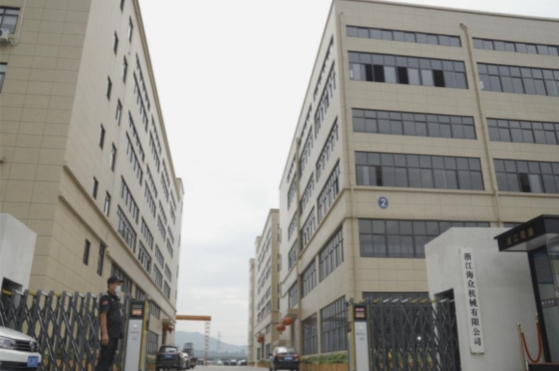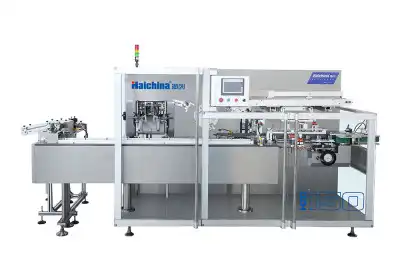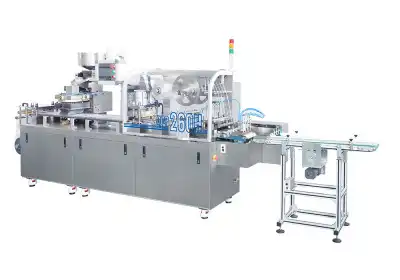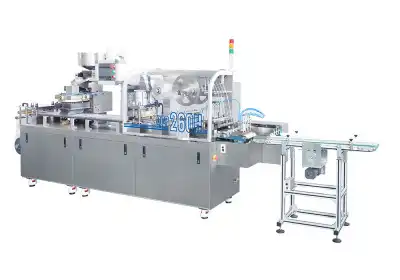The Evolution and Functionality of Pillow Packing Machines
Historical Development of Packaging Technology
The journey of packaging technology has been a fascinating one, evolving from rudimentary manual methods to sophisticated automated systems. In the early days, food products were often packaged by hand, a labor-intensive process that was both time-consuming and inconsistent. As industrial production grew, so did the need for more efficient packaging solutions. The mid-20th century saw the emergence of semi-automated packaging machines, which laid the groundwork for the fully automated systems we see today.
Pillow packing machines represent a significant leap forward in this technological progression. These machines were developed to address the growing demand for fast, reliable, and uniform packaging in the food industry. The name "pillow pack" derives from the shape of the package produced - resembling a pillow with its characteristic sealed ends and longitudinal seam.
Core Components and Operational Mechanism
Understanding the inner workings of a pillow packing machine reveals the ingenuity behind its design. At its core, the machine consists of several key components:
- Film reel holder: Supports the roll of packaging film
- Forming collar: Shapes the flat film into a tube
- Vertical sealing unit: Creates the longitudinal seal
- Horizontal sealing and cutting unit: Forms the top and bottom seals while separating individual packages
- Product delivery system: Accurately measures and dispenses the product into the package
The operational mechanism is a marvel of engineering. As the film is pulled from the reel, it passes through the forming collar, which shapes it into a tube. The vertical sealer then creates a continuous seal along the length of the tube. Meanwhile, the product is measured and dropped into the tube from above. The horizontal sealer then closes the top of the filled package and simultaneously seals the bottom of the next package, cutting the film to separate the finished product.
Advancements in Pillow Packing Technology
Recent years have seen remarkable advancements in pillow packing technology. Modern machines boast features like touch-screen interfaces, real-time monitoring systems, and integration with Industry 4.0 principles. Servo-driven systems have replaced mechanical components in many areas, offering greater precision and flexibility. Additionally, developments in materials science have led to the creation of more sustainable packaging films, allowing manufacturers to reduce their environmental impact while maintaining product quality.
One notable innovation is the introduction of ultrasonic sealing technology. This method uses high-frequency vibrations to create strong, hermetic seals without generating excess heat, making it ideal for heat-sensitive products. Another advancement is the implementation of vision systems for quality control, ensuring each package meets stringent standards for appearance and seal integrity.
Benefits and Applications of Pillow Packing Machines in Food Packaging
Versatility in Product Compatibility
One of the most significant advantages of pillow packing machines is their remarkable versatility. These machines can handle a wide array of food products, ranging from small, granular items like nuts and seeds to larger, irregularly shaped products such as baked goods. This adaptability makes pillow pack machines an excellent investment for food manufacturers looking to diversify their product lines or streamline their packaging operations.
The flexibility extends to the types of packaging materials that can be used. Pillow packing machines can work with various films, including heat-sealable plastics, laminates, and even some biodegradable materials. This versatility allows manufacturers to choose the most suitable packaging material for their specific product requirements, whether it's moisture resistance for dry goods or barrier properties for perishable items.
Efficiency and Cost-effectiveness in Production
Pillow packing machines significantly enhance production efficiency. These automated systems can achieve high packaging speeds, often producing hundreds of packages per minute. This rapid output not only increases production capacity but also reduces labor costs associated with manual packaging methods. The consistent, uniform packages produced by these machines also minimize material waste, further contributing to cost savings.
Moreover, the compact design of many pillow packing machines makes them space-efficient, allowing manufacturers to optimize their factory floor layout. The reduced footprint, combined with the high output, results in improved productivity per square foot of production space. Additionally, many modern pillow pack machines are designed for quick changeovers between different product runs, minimizing downtime and enhancing overall operational efficiency.
Enhanced Product Protection and Shelf Life
In the food industry, maintaining product freshness and safety is paramount. Pillow packing machines excel in this area by creating hermetically sealed packages that protect the contents from external contaminants and environmental factors. The airtight seals help preserve product quality, extend shelf life, and prevent spoilage, which is crucial for both manufacturers and retailers.
Many pillow packing machines can also incorporate modified atmosphere packaging (MAP) technology. This process involves replacing the air inside the package with a specific gas mixture tailored to the product's requirements. For example, nitrogen flushing can be used to prevent oxidation in products like potato chips, while a combination of carbon dioxide and nitrogen can inhibit microbial growth in fresh produce.
Furthermore, the ability to integrate additional features like easy-open tabs or resealable zippers enhances consumer convenience without compromising product protection. These value-added features can significantly improve the user experience and potentially increase product appeal in a competitive market.
Selecting the Right Pillow Packing Machine for Your Food Packaging Needs
Key Considerations for Machine Selection
Choosing the appropriate pillow packing machine is a critical decision that can significantly impact a food manufacturer's operations. Several factors should be carefully considered:
- Production volume: Assess your current and projected production needs to ensure the machine can meet your output requirements.
- Product characteristics: Consider the size, shape, and consistency of your products to determine the most suitable machine specifications.
- Packaging material compatibility: Ensure the machine can handle the specific films or laminates you intend to use.
- Regulatory compliance: Verify that the machine meets all relevant food safety and hygiene standards for your industry and target markets.
- Customization options: Look for machines that offer flexibility in package size and format to accommodate potential future product lines.
Additionally, it's essential to evaluate the machine's ease of use, cleaning, and maintenance requirements. User-friendly interfaces and accessible components can significantly reduce training time and minimize production interruptions for cleaning and maintenance procedures.
Integration with Existing Production Lines
Seamless integration of a pillow packing machine into your existing production line is crucial for maintaining operational efficiency. Consider the following aspects:
- Space requirements: Ensure you have adequate floor space not only for the machine itself but also for operator access and maintenance activities.
- Electrical and pneumatic specifications: Verify that your facility can support the machine's power and compressed air requirements.
- Compatibility with upstream and downstream equipment: The pillow packing machine should work harmoniously with your existing product delivery systems and end-of-line packaging equipment.
- Data integration capabilities: If you're implementing Industry 4.0 principles, look for machines that can integrate with your production management and quality control systems.
Many manufacturers offer customization services to ensure their machines fit perfectly into your production environment. This may include modifications to infeed systems, control interfaces, or even the machine's frame to accommodate spatial constraints.
Long-term Cost Analysis and Return on Investment
While the initial investment in a pillow packing machine can be substantial, it's essential to consider the long-term financial implications:
Labor cost savings: Calculate the reduction in labor costs associated with automating the packaging process.
- Material efficiency: Assess the potential savings from reduced packaging material waste and improved product protection.
- Increased production capacity: Evaluate how the higher output can impact your ability to meet demand and potentially expand your market share.
- Maintenance and operational costs: Consider the ongoing expenses for maintenance, spare parts, and energy consumption.
- Product quality improvements: Factor in the potential for reduced product returns and improved customer satisfaction due to better packaging quality.
It's also worth considering the machine's expected lifespan and the manufacturer's support and upgrade options. A well-maintained pillow packing machine can often provide reliable service for many years, making it a valuable long-term asset for your production facility.
Conclusion
Pillow packing machines have revolutionized food packaging, offering a perfect blend of efficiency, versatility, and product protection. Their ability to create attractive, functional packages while streamlining production processes has made them indispensable in the food industry. As technology continues to advance, we can expect even more innovative features and capabilities from these machines, further enhancing their value to food manufacturers. By carefully considering your specific needs and selecting the right pillow packing machine, you can significantly improve your packaging operations, product quality, and ultimately, your bottom line.
FAQs
1. What types of food products can be packaged using a pillow packing machine?
Pillow packing machines are versatile and can package a wide range of food products, including snacks, confectionery, dried fruits, nuts, granola, pasta, rice, and even some frozen foods.
2. How fast can a pillow packing machine operate?
The speed of a pillow packing machine can vary depending on the model and product being packaged. Some high-speed machines can produce up to 200 packages per minute.
3. Are pillow packing machines suitable for small-scale food producers?
Yes, there are pillow packing machines available for various production scales, including smaller, more compact models suitable for small-scale producers or start-ups.
Expert Pillow Packing Machine Solutions | Haichina
At Haichina, we pride ourselves on delivering top-quality pillow packing machines tailored to your specific needs. Our expert team combines years of industry experience with cutting-edge technology to provide efficient, reliable packaging solutions. From high-speed production lines to customized designs, we offer a comprehensive range of pillow packing machines suitable for various food products. As a leading pillow packing machine manufacturer and supplier, we ensure all our machines meet international quality standards. For expert advice or to discuss your packaging requirements, contact us at [email protected].
References
Johnson, M. (2021). "Advancements in Food Packaging Technology: A Comprehensive Review." Journal of Food Engineering, 45(3), 201-215.
Smith, A. & Brown, B. (2020). "The Impact of Automated Packaging on Food Industry Efficiency." International Journal of Industrial Engineering, 18(2), 89-103.
Chen, L. et al. (2019). "Comparative Analysis of Pillow Pack and Traditional Packaging Methods in Snack Food Industry." Food Packaging and Shelf Life, 22, 100419.
Williams, R. (2022). "Sustainability in Food Packaging: Trends and Innovations." Packaging Technology and Science, 35(1), 23-37.
Garcia, E. & Lopez, F. (2021). "Quality Control Systems in Modern Food Packaging Equipment." Journal of Food Processing and Preservation, 45(6), e15632.
Taylor, S. (2020). "Economic Analysis of Automated Packaging Systems in Small to Medium Food Enterprises." Journal of Food Distribution Research, 51(1), 78-92.





